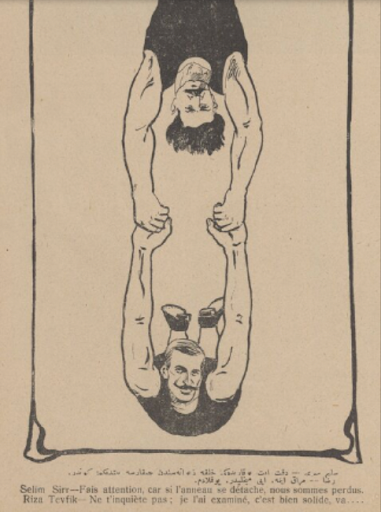We Were Never Silent: Bilingual Cartoons in the Ottoman Empire & Pidgin English in Chinese Text as Counter Narratives
Dale J. Correa and Suzanne Im highlight a bilingual magazine from the Ottoman Empire, and Pidgin English in Chinese text. Milton Machuca-Galvez, DeLisa Minor Harris, and Rachel E. Winston join the conversation to collectively discuss language representation in special collections.
Bilingualism and Cartoons as Language
In this segment, Dale J. Correa has chosen to focus on the bilingual Ottoman Turkish-French magazine Kalem (issued 1324-1328 AH/1908-1911 CE). UT Austin’s collections contain a remarkable number of periodicals from the early 20th century Middle East, including several that are multi-lingual. Kalem had been the prominent satirical or mizah gazette but was eventually shut down because of its criticism of Sultan Abdülhamid II and the reigning Ottoman political administration. This magazine is relatively unique as a bilingual satirical periodical from this time period because most Ottoman satirical gazettes were primarily in Ottoman Turkish. Even though a good portion of the population was illiterate, Kalem claims 10-13,000 readers in the first several weeks of publication. More significantly, those who were illiterate were nevertheless engaging with this magazine through its cartoons, usually in large social environments like coffeehouses and markets where the magazine could be passed from hand to hand. In this segment, Dale take us through a number of significant cartoons from Kalem to talk about how these cartoons are a form of language and expression beyond the magazine’s already unique bilingualism.
Keywords/tags: Ottoman Empire, satire, cartoons, literacy
This segment examines The Chinese and English Instructor (1862) by T’ong Ting-ku following the theme of language and counternarrative. Developed by a Chinese merchant, this work is a prime example of the use of “language from below” in the form of Pidgin English. In traditional Chinese society, the merchant class was considered the lowest in the Chinese social hierarchy, and many of them had no or limited formal education. Economic, social, and political factors contributed to the rise of Chinese Pidgin English as a bridge language for the purposes of business and trade.
Keywords/tags: Conversation and phrase books, dictionaries, Pidgin English, Chinese language
